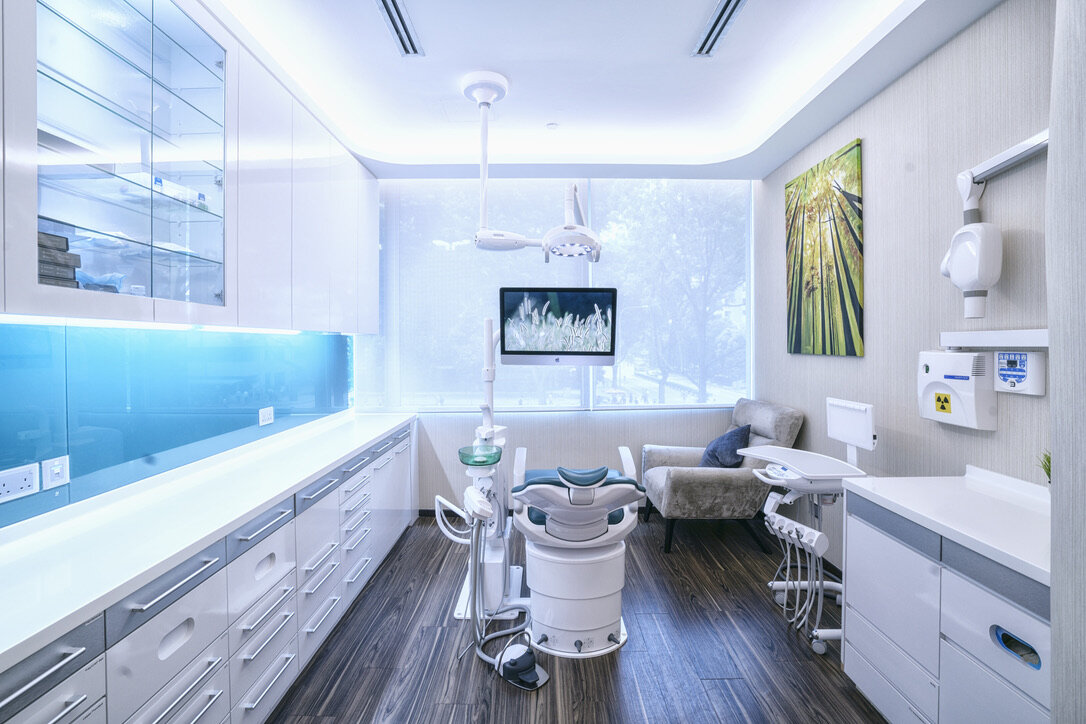
Orthodontics
What is Orthodontics?
Orthodontics is the branch of dentistry that specialises in the diagnosis, prevention and treatment of malpositioned teeth and jaws. A bad bite is referred to as a malocclusion and it can be caused by the teeth position and/or the jaw position.
Some of the common conditions that require orthodontic treatment include but are not limited to:
Crooked teeth
Impacted teeth (adult teeth that are stuck)
Upper front teeth sticking out
Lower front teeth in front of upper front teeth (commonly termed as an “underbite”)
Spaces in between teeth
Anterior open bite, front teeth not touching
Missing teeth requiring replacement and alignment of teeth prior to prosthetic replacement
Crossbite correction where the teeth are not biting in a proper relationship
Traumatic bite where the bite is causing damage to the gums
Is Orthodontics all about aesthetics only?
While one of the goals of Orthodontics is to achieve an aesthetic outcome, another primary goal of treatment is also to improve function. Such as when an impacted tooth is brought into proper function with the help of braces treatment and when traumatic bites are corrected and no longer causing gum recession.These are just some examples of the important role orthodontics has to play in overall dental health.
Orthodontics in children
The American Association of Orthodontics recommends a visit to the orthodontist no later than age 7. As some dental malocclusion can be corrected or prevented early. These include:
Early treatment to:
guide jaw growth
lower the risk of trauma to protruded front teeth
correct harmful oral habits (Such as thumb sucking)
improve appearance
guide permanent teeth into a more favorable position
improve the way lips meet
Every child is different and so are their dental needs, though not every child needs orthodontics. Some may benefit from early interceptive treatment, hence is it best to arrange for a consultation for our orthodontist to have an assessment.
Orthodontics in adults
Most people think that braces or orthodontics are just for young people, however there is a growing trend for adults to seek orthodontic treatment due to the advances in orthodontic appliances. In fact, most adults find that as they get older, their teeth have shifted and have become more crooked than before. There is a term called: “late lower arch crowding” which the lower front teeth become crooked as one gets older due to changes in their growth and bite forces.
Furthermore, some adults delayed treatment until they are now financially ready to make the commitment. Teeth can move at any age and orthodontic treatment is suitable for all individuals with healthy teeth and bone support, regardless of age.
Some of the appliances that may be more suitable for adults include:
Clear braces
Clear aligners
Lingual braces
Clear braces
Clear braces are made from ceramic or sometimes plastic. They work similar to conventional braces in that wires and rubber bands are needed to apply forces on the teeth. These types of braces are less obvious than metal braces as the colour of the braces matches the teeth colour and from a photo it may sometimes not be obvious that one is wearing braces. However the wire is still visible and the clear rubber bands used may stain with certain foods, clear braces also tend to be slightly bulkier than metal braces. Clear braces are a good option for those patients who are not suitable for aligner treatment but do not want the braces to be visible.
Clear aligners
Clear aligners are customised plastic trays that are designed to progressively shift teeth. They are a type of removable braces. These are some of the advantages and disadvantages of clear aligners.
Advantages:
Aesthetic
More comfortable compared to braces
Less painful compared to braces
No diet constraints
Disadvantages
Needs to be removed for meals and brushing teeth
Needs to be cleaned at least twice a day
Usually costs more compared to braces
With the introduction of 3D technology, there are many laboratories in the market that produce clear aligners. The first mover in this clear aligner market is the popular brand Invisalign. Invisalign is able to correct not only simple malocclusion, the technology has improved and Invisalign is also able to manage complex cases and in certain situations may be a better option compared to conventional braces.
Read all about Invisalign at TOOFDOCTOR here.
At TOOFDOCTOR Dental Centre, we also offer in-house clear aligners, these are clear aligners that are fabricated by our own in-house laboratory. These are suitable for mild crowding, single tooth movements and braces relapse cases. The advantage of in-house aligners is that because we do not have to outsource to an external laboratory, the cost is lower, however as mentioned it is suitable for simpler cases.
Lingual braces
Lingual braces are braces that are attached to the tongue side of the teeth. This appliance is the most aesthetic type of braces as it is truly “invisible”. As the tooth surface on the tongue side is more irregular and the space for bonding the braces are smaller, these braces have to be customised to the shape of the teeth. They also do cause more ulcers to the tongue and require a longer duration to get used to these braces.
